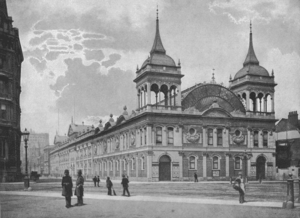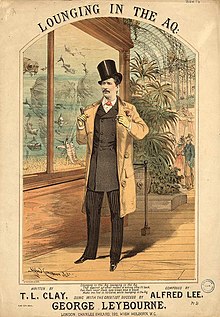
Emilie Charlotte, Lady de Bathe, known as LillieLangtry and nicknamed "The Jersey Lily", was a British socialite, stage actress and producer.

The Palace Theatre is a West End theatre in the City of Westminster in London. Its red-brick facade dominates the west side of Cambridge Circus behind a small plaza near the intersection of Shaftesbury Avenue and Charing Cross Road. The Palace Theatre seats 1,400.

The human cannonball act is a performance in which a person who acts as the "cannonball" is ejected from a specially designed cylinder that has been designed to resemble a cannon. The human cannonball lands on a horizontal net or inflated bag placed at the landing point, as predicted by physics. Outdoor performances may aim at a body of water.

The Noël Coward Theatre, formerly known as the Albery Theatre, is a West End theatre in St. Martin's Lane in the City of Westminster, London. It opened on 12 March 1903 as the New Theatre and was built by Sir Charles Wyndham behind Wyndham's Theatre which was completed in 1899. The building was designed by the architect W. G. R. Sprague with an exterior in the classical style and an interior in the Rococo style.
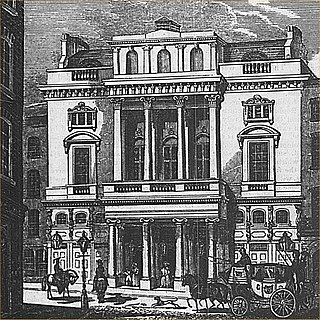
The St James's Theatre was in King Street, St James's, London. It opened in 1835 and was demolished in 1957. The theatre was conceived by and built for a popular singer, John Braham; it lost money and after three seasons he retired. A succession of managements over the next forty years also failed to make it a commercial success, and the St James's acquired a reputation as an unlucky theatre. It was not until 1879–1888, under the management of the actors John Hare and Madge and W. H. Kendal that the theatre began to prosper.

The Opera Comique was a 19th-century theatre constructed in Westminster, London, located between Wych Street, Holywell Street and the Strand. It opened in 1870 and was demolished in 1902, to make way for the construction of the Aldwych and Kingsway.

Evelyn Laye was an English actress and singer.

The Lyric Theatre is a West End theatre in Shaftesbury Avenue in the City of Westminster. It was built for the producer Henry Leslie, who financed it from the profits of the light opera hit, Dorothy, which he transferred from its original venue to open the new theatre on 17 December 1888.

The Scala Theatre was a theatre in Charlotte Street, London, off Tottenham Court Road. The first theatre on the site opened in 1772; the last was demolished in 1969, after a catastrophic fire. From 1865 to 1882, the theatre was known as the Prince of Wales's Theatre.

Nude with Violin is a play in three acts by Noël Coward. A light comedy of manners, the play is a satire on "Modern Art", criticism, artistic pretension and the value placed on art. It is set in Paris in 1956 and portrays the effect on the family and associates of a famous artist when it is revealed after his death that he painted none of the pictures signed by him and sold for large sums. The action is mostly under the discreet control of the artist's valet, Sebastien, who manipulates events to bring about a happy ending for all the characters.

The Globe was a Victorian theatre built in 1868 and demolished in 1902. It was the third of five London theatres to bear the name, following Shakespeare’s Bankside house, which closed in 1642, and the former Rotunda Theatre in Blackfriars Road, which for a few years from 1833 was renamed the Globe. The new theatre was also known at various times as the Royal Globe Theatre or Globe Theatre Royal. Its repertoire consisted mainly of comedies and musical shows.

William Leonard Hunt, also known by the stage name The Great Farini, was a well-known nineteenth- and early twentieth-century Canadian funambulist, entertainment promoter and inventor, as well as the first known white man to cross the Kalahari Desert on foot and survive. He also published under the name Guillermo Antonio Farini.

Toole's Theatre, was a 19th-century West End building in William IV Street, near Charing Cross, in the City of Westminster. A succession of auditoria had occupied the site since 1832, serving a variety of functions, including religious and leisure activities. The theatre at its largest, after reconstruction in 1881–82, had a capacity of between 650 and 700.
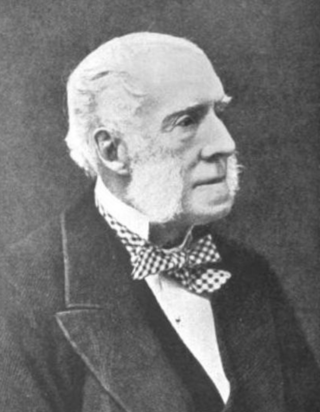
Charles Morton was a music hall and theatre manager. Born in Hackney, east London, he built the first purpose-built Tavern Music hall, the Canterbury Music Hall, and became known as the Father of the Halls.
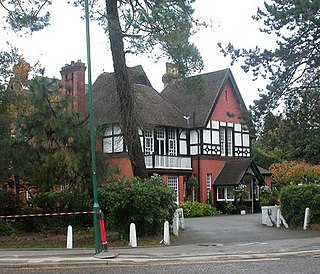
The Langtry Manor is a country house hotel at 26 Derby Road in the East Cliff area of Bournemouth, England. The foundation stone is inscribed "E.L.L. 1877". A residence for 60 years, it was originally known as the "Red House", and after 1937 the "Manor Heath Hotel", before being renamed the Langtry Manor in the late 1970s.

Oxford Music Hall was a music hall located in Westminster, London at the corner of Oxford Street and Tottenham Court Road. It was established on the site of a former public house, the Boar and Castle, by Charles Morton, in 1861. In 1917 the music hall was converted into a legitimate theatre, and in 1921 it was renamed the New Oxford Theatre. In May 1926 it closed and was demolished.
The Queen Was in the Parlour: a romance in three acts is a play by the English writer Noël Coward. Although written in 1922 it was not produced until 24 August 1926, when it was premiered at the St Martin's Theatre.
Edgar Israel Cohen (1853–1933) was a British sponge and cigar merchant working in London, England, who later became involved with retail, entertainment, and popularised the motorised London taxicab in 1906. He became associated with the flotation of several family owned businesses of the period including Harrods department store. He was a close friend of Lillie Langtry and provided funding for her theatrical ventures in 1900.

Rossa Matilda Richter, who used the stage name Zazel, was an English aerialist and actress who became known as the first human cannonball at the age of 17. She began performing at a very young age, practicing aerial stunts like tightrope walking in an old London church. She took up ballet, gymnastics, and trapeze by the time she was 6 and, at 12, went on tour with a travelling acrobat troupe. In 1877, she was the first person to be fired out of a cannon, in front of a large crowd at the Royal Aquarium.

Marie Loftus was a British music hall entertainer of the late Victorian era often billed as "The Sarah Bernhardt of the Music Halls" and "The Hibernian Hebe". She became one of the leading stars of music hall from the 1880s to World War I.
